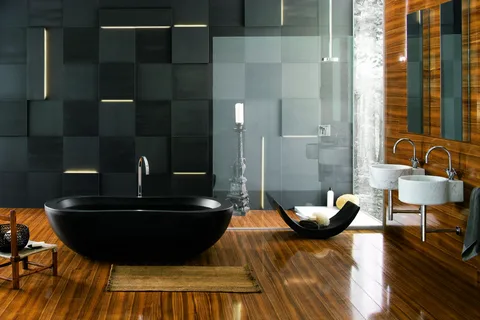Bathroom tiles are more than just functional elements—they play a crucial role in the aesthetics, comfort, and durability of the bathroom. With the variety of materials, sizes, textures, and patterns available, choosing the right bathroom tiles can transform a bland space into a stylish and serene retreat. This blog post will dive into the different types of bathroom tiles, their benefits, design trends, and tips on selecting the perfect tile for your bathroom. Whether you’re renovating or building a new bathroom, this guide will help you make informed decisions to create your dream bathroom.
Understanding the Different Types of Bathroom Tiles
Before diving into tile design, it’s important to understand the various types of Bathroom Tiles available, as each material offers unique benefits:
Ceramic Tiles
Ceramic tiles are made from clay and are popular for their affordability and versatility. They come in a wide range of colors, shapes, and finishes, making them suitable for almost any bathroom style. Ceramic tiles are water-resistant, easy to clean, and a durable choice for both walls and floors.
Porcelain Tiles
A subtype of ceramic tile, porcelain is denser and more resistant to moisture, making it a perfect choice for bathrooms. Porcelain tiles are highly durable, resistant to stains, and can mimic the look of natural stone, wood, or concrete. They’re suitable for high-traffic areas and can be used for both floors and shower walls.
Glass Tiles
Glass tiles add a touch of elegance and shine to a bathroom. They are non-porous, meaning they do not absorb water, making them ideal for shower walls or as a decorative backsplash. However, they can be slippery when wet, so they are best used on walls or in low-traffic areas.
Natural Stone Tiles
Stone tiles like marble, granite, limestone, and slate offer a luxurious, timeless appeal. Each piece of stone tile is unique, with variations in color and texture, adding a natural feel to the space. While stone tiles are beautiful, they require regular sealing to prevent staining and moisture damage.
Mosaic Tiles
Mosaic tiles are typically small tiles made of ceramic, porcelain, glass, or natural stone, arranged in intricate patterns. These tiles can add texture and visual interest, especially when used as an accent or feature wall.
Vinyl Tiles
Vinyl tiles are an affordable and practical option for bathroom floors. They are waterproof, easy to install, and come in a wide range of designs, including those that mimic wood or stone. Vinyl tiles are comfortable underfoot and can provide a budget-friendly way to refresh the bathroom.
The Benefits of Bathroom Tiles
Choosing tiles for your bathroom offers several benefits, making them a popular choice for modern homes:
Water Resistance
Bathrooms are humid environments, and tiles are excellent at withstanding moisture. Ceramic, porcelain, and glass tiles are particularly water-resistant, which prevents the growth of mold and mildew.
Durability
Tiles, especially ceramic and porcelain, are incredibly durable and can last for many years with minimal maintenance. They are resistant to scratches and stains, making them ideal for bathrooms with heavy use.
Easy to Clean and Maintain
Tiles are non-porous and easy to wipe down, which is essential in a bathroom setting. This quality makes them a hygienic choice, as they do not harbor bacteria or odors.
Versatile Design
Bathroom tiles come in various styles, colors, patterns, and textures, allowing for endless design possibilities. Whether you prefer a modern, minimalist look or a classic, vintage vibe, there is a tile to match your vision.
Current Bathroom Tile Design Trends
Staying on top of current design trends can help you choose bathroom tiles that not only look great today but will continue to appeal for years to come. Here are some popular tile design trends to consider:
Large Format Tiles
Large tiles reduce the number of grout lines, creating a seamless, open look in the bathroom. They can make a small bathroom appear larger and are available in various materials, including porcelain and natural stone.
Bold Patterns and Colors
Gone are the days of plain white bathrooms. Bold, patterned tiles, especially those with geometric or floral designs, are increasingly popular. They add personality and can serve as a focal point in the bathroom, especially when used on a feature wall or floor.
Textured Tiles
Adding texture to bathroom walls through textured or 3D tiles can create a visually stunning effect. These tiles can mimic natural materials such as stone or wood, adding depth and character to the space.
Matte Finishes
Matte tiles offer a soft, understated look that is perfect for contemporary bathroom designs. They are less likely to show water spots and smudges compared to glossy tiles, making them a practical choice for busy bathrooms.
Subway Tiles
A classic choice that never goes out of style, subway tiles are typically rectangular tiles that are laid in a staggered pattern. They are versatile and can be used in traditional or modern settings, depending on the grout color and tile arrangement.
Wood-Look Tiles
Wood-look porcelain tiles give the appearance of hardwood flooring while maintaining the water resistance of porcelain. They are an excellent option for those who want the warmth of wood in a bathroom without compromising on practicality.
How to Choose the Right Bathroom Tile
Selecting the right bathroom tile involves balancing aesthetics with functionality. Here are some factors to consider when choosing bathroom tiles:
Assess the Space
Consider the size and layout of your bathroom. In smaller bathrooms, using light-colored tiles or larger formats can help make the space appear bigger. Darker tiles add a dramatic touch but may make a small bathroom feel more confined.
Consider Tile Placement
Think about where the tiles will be installed. Floor tiles need to be durable and slip-resistant, while wall tiles can be more decorative. Shower tiles should have low water absorption and be easy to clean.
Choose the Right Material
Each tile material has its own advantages and disadvantages. Porcelain and ceramic are versatile and durable, while natural stone adds luxury but requires maintenance. Choose the material that best fits your lifestyle and budget.Think About Maintenance Some tiles, like natural stone, require more maintenance than others, such as ceramic or porcelain. If you prefer a low-maintenance bathroom, opt for tiles that are easy to clean and resistant to stains.
Don’t Forget About Grout
Grouting significantly impact the appearance of your bathroom tiles. Dark grout can hide stains but may stand out against light tiles, while light grout blends seamlessly but can show dirt more easily. Seal your grout to protect it from moisture and stains.
Tips for Installing Bathroom Tiles
Once you’ve chosen your tiles, proper installation is crucial to ensure they look great and last for years:
Prepare the Surface
Ensure the surface is clean, dry, and level before installing tiles. Any unevenness can cause the tiles to crack or shift.
Use a Waterproof Membrane
Apply a waterproof membrane to areas that will be exposed to water, such as shower walls and floors. This step prevents water from seeping behind the tiles.
Select the Right Adhesive
Use an adhesive that is suitable for your tile material and the bathroom environment. For example, choose a waterproof adhesive for shower tiles.
Pay Attention to Grouting
Proper grouting is essential for a polished finish. Use a grout that complements the tile color, and consider sealing the grout to protect it from moisture and stains.
Hire a Professional for Complex Designs
If your tile design is intricate or involves unusual patterns, consider hiring a professional tile installer. They have the skills and tools to ensure a flawless finish.
Maintaining Your Bathroom Tiles
To keep your bathroom tiles looking their best, follow these maintenance tips:
Regular Cleaning
Wipe down tiles regularly with a mild cleaner to prevent soap scum and hard water deposits from building up.
Seal Natural Stone Tiles
If you have natural stone tiles, reseal them every few years to maintain their resistance to stains and moisture.
Address Grout Stains Quickly
Clean grout stains as soon as they appear to prevent discoloration. A mixture of baking soda and water can help remove stubborn stains.
Conclusion
Bathroom tiles offer endless possibilities for creating a functional and beautiful space. With the right choice of material, design, and installation, your bathroom can become a luxurious retreat that reflects your personal style. Consider the benefits, trends, and tips outlined in this guide to make informed decisions, ensuring your bathroom tiles stand the test of time while adding aesthetic value to your home.





